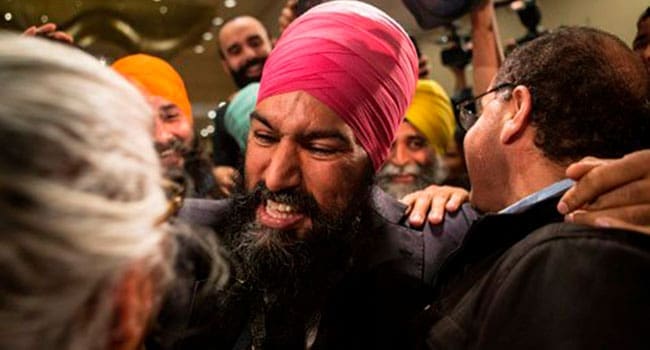 The election of Jagmeet Singh as the new federal New Democratic Party leader is a game changer for the Canadian political landscape.
The election of Jagmeet Singh as the new federal New Democratic Party leader is a game changer for the Canadian political landscape.
Singh, a 38-year-old lawyer, has his feet firmly planted in Canada’s multicultural community. He’s a bearded, turban-wearing Sikh who carries a kirpan, and speaks English, French and Punjabi fluently.
New Democrats have astutely read the Canadian political tea leaves and concluded that the multicultural community is a force to be reckoned with at the ballot box.
Courting the votes of Canada’s multicultural community started with Pierre Elliot Trudeau and the Liberal Party. In 1971, Prime Minister Trudeau stood up in the House of Commons and announced Canada’s multicultural policy. It was a convincing signal to the multicultural community to park their votes with the Liberals.
Later, the election of Conservative Prime Minister Brian Mulroney, whose wife Mila was born in the former Yugoslavia, changed the direction of the multicultural vote. Mulroney’s determination to give the Canadian multicultural community a voice in public policy found expression in his appointments to federal agencies, commissions and boards.
But Mulroney’s most significant accomplishment was to elevate Canada’s multicultural policy to a higher level by introducing a Multiculturalism Act. It was a first on the international landscape.
Mulroney conveyed the message that Canada had become a multicultural country in fact and in law. Suffice to say, he was popular among the multicultural community and a magnet for multicultural votes.
There have certainly been other champions of the multicultural community in Canada.
The late Sava Bosnitch was a longtime Fredericton, N.B., resident and a professor of political science at the University of New Brunswick. Bosnitch, who was also Mila Mulroney’s godfather, was a passionate advocate for the multicultural community and a tireless defender of the community’s human rights.
More recently, Jason Kenney, one-time minister of immigration in Steven Harper’s Conservative government, recognized the political clout of the multicultural community and attempted to attract a larger share of those votes for his party.
But the face of contemporary Canada has changed significantly. Immigration streams from Asia, Africa and South America have accelerated the diversity of the Canadian population mosaic. In addition, recent refugee movements from the Middle East and Asia have deepened our cultural and religious diversity.
Contemporary Canadians don’t have the same hang-ups as their parents about cultural diversity. They’ve grown up with that diversity in school, played hockey and baseball with and had boyfriends and girlfriends from the multicultural community.
By choosing Singh, the NDP members are sending a powerful signal to the multicultural community. The full and equal participation of the multicultural community in building a better Canada is now a foundational part of the political structure.
Singh’s election also sends a message to the other political parties: platitudes and hollow promises won’t cut it anymore.
Parties preparing for the next federal election in 2019 must recognize the political importance of the multicultural community. They need game plans that are visionary and strategic. They must connect in purposeful ways with the multicultural community.
It reminds me of the difference between playing backgammon and chess. In backgammon, you roll the dice and hope for the best. With chess, you pick your moves strategically with an eye on the prize.
So Canadian political parties should embrace the words of Robert F. Kennedy, who said: “There are those that look at things the way they are, and ask why? I dream of things that never were, and ask why not?”
Dr. Constantine Passaris is a professor of Economics at the University of New Brunswick and a national research affiliate of the Prentice Institute for Global Population and Economy at the University of Lethbridge.
Constantine is a Troy Media Thought Leader. Why aren’t you?
The views, opinions and positions expressed by columnists and contributors are the author’s alone. They do not inherently or expressly reflect the views, opinions and/or positions of our publication.

